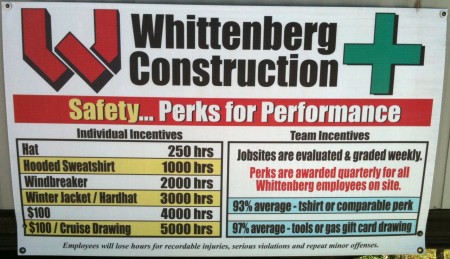Steve Akers of Louisville writes:
“I know from your blog that you like signs, so I’m attaching the photo of a sign I saw at our local zoo this past weekend. It is not emotionally intelligent, but it certainly illustrates extreme extrinsic motivation. It seems this construction company feels that company swag is exactly the kind of thing that will motivate employees to stay safe. I can hear the employees now, ‘Well I was going to carelessly wave this nail gun around for a while, but I’ve got my eye on that windbreaker.’“

I’m not sure if I read this in Dan’s book or some other behavioral economics text, but research shows that in-kind rewards are better motivators than cash.
The author of the sign may have read the same text, since I remember that one of the examples in the above research involved motivating a sales team to compete against one another to win a cruise. Top prize for being a safe worker? Chance to win a cruise (or $100, let’s not go whole hog on evidence-based management)!
This might be good for motivation but it risks motivating the wrong thing. It encourages injuries to go unreported which undermines any honest effort to evaluate and improve safety.
Hey those windbreakers are custom made with company logo and all.
BTW thanks for Drive, a wonderful book. I’ll be reading the ones you recommended in it too.
The biggest problem with this sign is the utter contempt it shows toward workers. Are the penalties doubled if somebody injures some chunderhead from corporate? Wouldn’t it still be worth it?
They might be better off stating a jacket will be rewarded will be offered for 0 violations on walk-through inspections. Downgrade to a hoodie for minor safety infractions corrected within XX hours. Rewards for production enhancement ideas will be determined based on the anticipated value.
Accidents/incidents reported immediately will not affect group incentives. (Careful with this one) Failure or avoidable delays in reporting will put all rewards at risk. Rewards are offered for doing things right and contributing ideas. Penalties are associated with failure to follow procedures or take initiative.
Is the $100 worth the almost two years you need to work (at 8 hrs a day) to get it?
Windbreaker after one year?
Interesting.
By the time you get the 5000 hrs in, you are halfway to becoming the 10,000 “outlier” expert…you better have safety down!
Gershie makes a very important point. I get angry with such programs like this that encourage employees to do the opposite of what you want — like under-report safety incidents, or “attendance programs” that only encourage employees to come to work sick and infect the rest of the office.
People SHOULD come to work; people SHOULD behave/work in a safe manner. Rather than incent them with a silly and insulting program such as this, perhaps consider recognizing and appreciating them after the fact. In Dan’s terminology — “after/that recognition.”
My favorite sign was on the way into a ropes course near Nanaimo B.C. The sign read “Caution – Anti-Speed Holes” (in other words – pot holes)! I thought it was a brilliant example of re-purposing something that is actually an annoyance to control traffic speeds.
I think this is a great sign! For all the harsh comments, consider this : \This is a company who cares enough about their employees to spend money on safety.
Whether it’s a cheesy “free swag” giveaway, or a sign or whatever, this snapshot shows underlying policies and a company culture that promotes safety.
Yes, it could lead to unreported accidents if not monitored; but it seems that this company drives safety into its very core. After having been on the scene of a decapitated 19 year old at a bakery last week – this brightened my day.